IBM's ThinkPad T42 LCD: A Blast from the Past
by Jarred Walton on December 7, 2010 7:30 PM ESTIBM's ThinkPad T42 LCD: A Blast from the Past
As a vocal proponent of improving laptop LCD quality—and LCD quality for desktops as well—the past few years have been painful. True, laptop LCDs have never been at the level of their desktop counterparts, but once upon a time there were at least a few laptops that didn't use TN panels. One of those is the vaunted IBM ThinkPad T42, launched way back in 2004. Besides coming before virtually everything migrated to widescreen displays, the T42 is one of the few laptops to use an IPS panel. As luck would have it, I recently had a chance to use a T42, and I took the opportunity to run it through our standard set of LCD tests. Mostly I was curious to see the results, but I figured some of our readers would enjoy getting our impressions of this archeological find as well.
Before we get to the display, let's make a few other points about this venerable old soldier. First, it's absolutely astonishing how well a six-year-old laptop continues to hold together—a true testament to the ThinkPad engineering team. The LCD hinges are still fully intact and work well, the chassis still feels solid, and the particular T42 I had access to is even running Windows 7…and running it rather well, actually! Of course, this was no entry-level laptop back when it was purchased. It has 2GB of DDR-266 RAM, a fast 1.8GHz Pentium M 745 (Dothan) processor, and it even includes a powerful (at the time) Mobility Radeon 9600 with 64MB of RAM. You might laugh at some of those specs, but this system will still run circles around Atom and it checked in at roughly $2500 at the time of purchase. Then again, six years of use for $2500 is pretty darn impressive.
About the only area where the T42 truly struggles compared to modern laptops is in handling HD video; sadly, the Radeon 9600 has no video decode acceleration for H.264 content, so even standard YouTube content can feel a bit choppy, and forget about HD videos. Going fullscreen on SD YouTube (and other Flash videos) definitely struggles, but not to the point where I'd say it's unwatchable—but again, forget about the HD videos. Another component that fails to impress after all these years is the old 80GB 5400RPM Fujitsu hard drive, and with its IDE interface you won't be upgrading to one of the latest and greatest SSDs. Outside of HD multimedia, however, the T42/Pentium M platforms of old still run well enough for most tasks. General office and Internet use isn't a problem, and Windows 7 32-bit gets along quite well with the 2GB RAM. Where most consumer laptops from 2004 have long since retired to the scrap heap with broken hinges, casing, failed motherboards, etc. the ThinkPad keeps plugging along.
But then, you didn't come here for a review of the T42 six years after launch. My main interest in this laptop is the LCD; all it takes is a few seconds looking at the display from acute vertical angles and it becomes immediately apparent that this is not your typical TN panel. As a point of reference for just how easy it is to tell the difference, look at the shots below showing the T42 with the Dell E6410. The E6410 LCD is substantially brighter (200nit laptops simply didn't exist in 2004, let alone 300nit options), but the above and below angles are all but useless.
The sheer brightness of the E6410 can be misleading, and clearly a dim panel from 2004 isn't going to win every comparison. However, laptops are devices where you frequently view content from above or below (i.e. sitting in a cramped airplane seat), and forcing everyone to use TN panels with lousy vertical viewing angles definitely isn't in our best interest. The technology was in use over six years ago, and there's nothing to stop LCD manufacturers from offering better panels…other than the almighty bottom line.
Before we get to the charts, the other item worth discussing is the resolution and aspect ratio. I don't have a major problem with widescreen displays, but there's a limit to how far we should go, and 16:9 is either at the limit or beyond it depending on your perspective. Widescreen is nice for movies (as long as they're also widescreen), but for most other tasks regular displays work fine, and 768p in particular is a very bad resolution to standardize on. With a WUXGA or even 1080p display, there's at least enough room to view two document/web pages side by side, but drop to 1366x768 and all you get is a short display that's a bit wider than your average website. The T42 I'm looking at has a 15" SXGA+ (1400x1050) display, which works out very nicely on this size chassis. Comparing it to a modern Dell Latitude E6410, the Latitude is about .4" wider but the T42 is a good 1" to 1.2" deeper/taller. The T42 dot pitch is also slightly finer (125dpi vs. 120dpi on the 14.1" WXGA+).
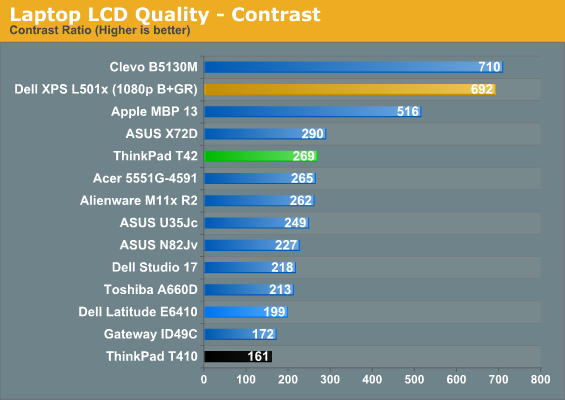
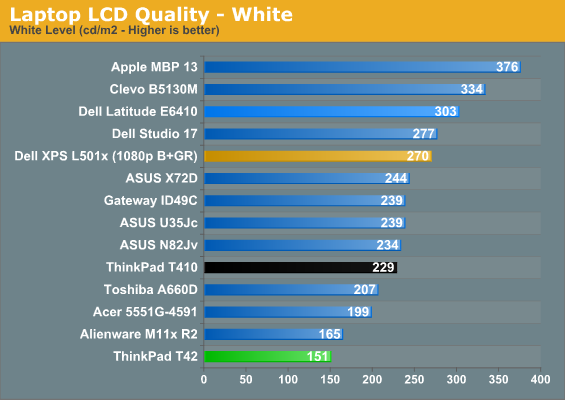
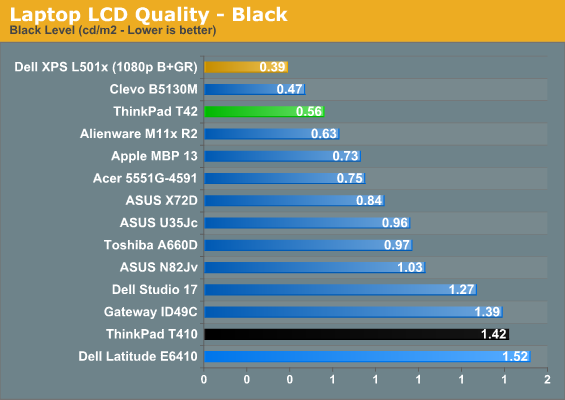
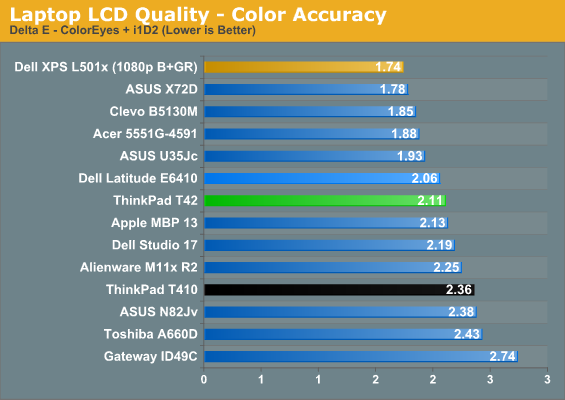

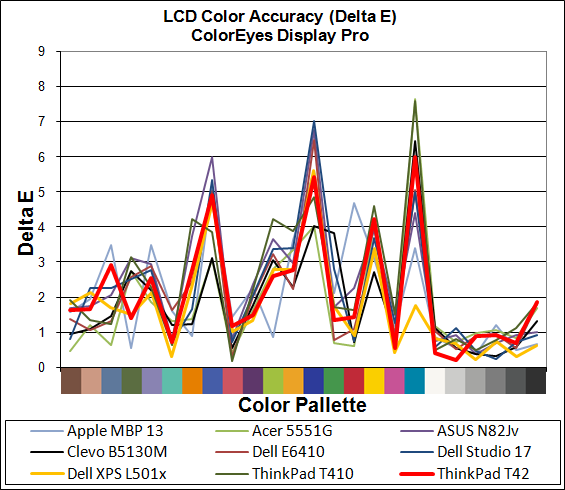
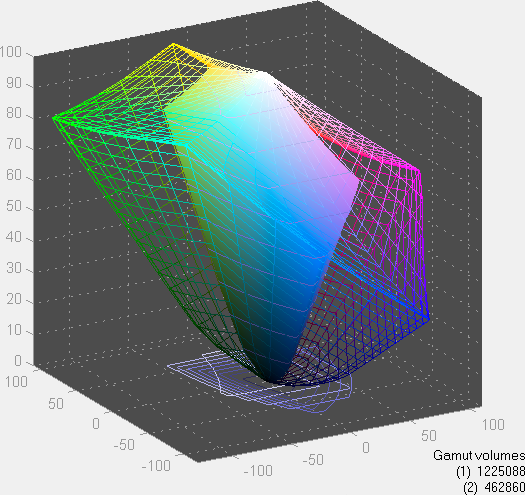
So after all the good things we've said, you might have expected this to be a clear cut decision in favor of the ThinkPad Flexview displays. While it definitely wins the vertical viewing angle comparison, in other areas it's still a product of its time. Color accuracy is good if not great, but the contrast ratio is only moderately higher than most modern LCDs at 270:1. Granted, we're looking at a matte LCD (another bonus point!), so if this were a modern glossy equivalent you'd be looking at around 325:1, but then there are plenty of other things that have changed.
One big change is the backlighting, which is why a six-year-old LCD manages a color gamut of just 39% and 150nits brightness, both at the bottom of our charts. Besides providing for potentially improved color gamut—obviously, you can still have a low color gamut as the T410, E6410, and other laptops show—modern LED backlighting is typically far brighter than any old CCFL backlight. Even at maximum brightness, there are plenty of times where the T42 LCD still feels dim.
Ultimately, what I'm most interested in showing is how viewing angles really do matter on laptops and the difference an IPS panel can make. Apple is one company that actually understands this, as they used an IPS panel in the iPad. That's something many of the competing slates are completely overlooking, with the result being a tablet that you can't look at from certain angles. And with a modern IPS display, the iPad manages a stunning near-1000:1 contrast ratio. For obvious reasons (touch screen), the iPad has a glossy, scratch-resistant coating, but even with the 20% "matte contrast tax" you can easily make matte IPS displays that achieve 750:1 or higher contrast. I would love to see some laptop manufacturers push the LCD makers to create more such panels. I don't care if they cost $150 more, provided the quality is there—just imagine something like the high color gamut RGB LED backlit displays, only coupled to a matte IPS panel.
What I have to wonder is if all of this talk of laptop LCDs only matters to a small percentage of users. Obviously IBM tried to offer IPS in the Flexview displays six years back; why don't they still have that option? HP's EliteBook 15" and 17" have the DreamColor IPS panels as a modern alternative, and we'll look at one of those shortly, but it's a costly upgrade. If there were more quality panels in use, economies of scale comes into play and prices go down, but it doesn't look like there's much interest in creating less expensive IPS panels when you can make even cheaper TN displays.
Perhaps the majority of buyers spoke, and what they said is that they don't care about LCD quality. Or more accurately, they probably said that they're okay with lesser displays as long as the price is substantially lower. Today, we're stuck with tons of low contrast, 16:9, 768p, glossy TN panels as a result, and unless/until we see OLED or some other technology move to the forefront, that trend looks set to continue. What can we do about changing the current status quo? Beyond writing articles like this and praising high quality laptop LCDs, I'm out of ideas, but feel free to join me in the comments by asking for better display options!
Update: Ironically, as I was testing this old T42 laptop, Dustin was putting the finishing touches on his HP EliteBook 8740w review. $2500 for the ThinkPad T42 back in 2004 probably sounded like an awful lot of money, but it held up well over the years. Perhaps the 8740w (or the slightly smaller 8540w) can do the same, and to the best of my knowledge HP's DreamColor laptop LCDs are one of the few current IPS panels shipping. I'm not sure if there are any others. The ThinkPad W510 is an RGB LED panel but it's still TN I believe; the W701ds uses the same RGB LED backlit panel as the Dell M6500, again not IPS. (Please correct me if I'm wrong, though!)


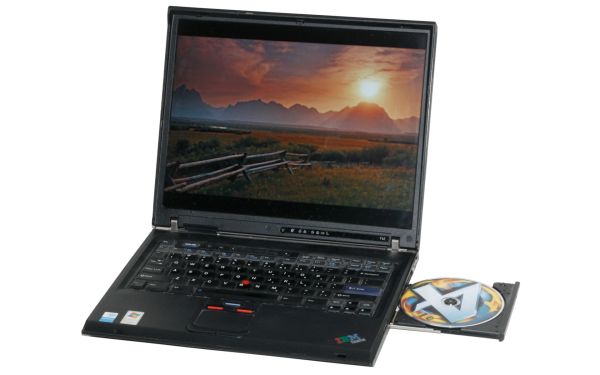














98 Comments
View All Comments
habbakuk87 - Wednesday, December 8, 2010 - link
I am using a R 50e Thinkpad and it is working very good. Praise to be IBM. I totally get the build quality , hinge quality and the need for better LCDs. I need my eyeline to be within specific position especially when watching videos.gbtidi - Wednesday, December 8, 2010 - link
I picked up an Thinkpad T60 a couple of years ago in an auction by a company that was upgrading its workstations. After fitting a new HDD and a new wireless card, it runs OS X Snow Leopard 10.6.5 perfectly. 1400x1050 matt IPS 4:3 screen (a bit dim, but fine for coding), solid chassis and keyboard, 4 hour battery and fast-enough Core 2 Duo. Not bad for £75!Markstar - Wednesday, December 8, 2010 - link
...I just bought a T60 from Ebay recently to replace my (even older) laptop. The 15" also has an IPS panel but even the 14" are very nice since you can barely find the 1400*1050 resolution anywhere. Upgrade it with an SSD and a decent CPU (it goes up to the T7400, but imo, any 1.8GHz dual core is enough for most user's needs) and you have something that makes sense another 5 years.I also started equipping friends and family with this. As has been said - the screen resolution is extremely nice, it's sturdy, the keyboard is nice, you still get tons of replacement parts for it and it's quick enough for pretty much any non-gamer.
Markstar - Wednesday, December 8, 2010 - link
Oh, and did I mention that these beauties go for less than 200 bucks nowadays?strikeback03 - Wednesday, December 8, 2010 - link
I'm considering doing the same thing, but the ones I have been seeing have been more like $400-500, guess I'll have to keep looking.max40watt - Wednesday, December 8, 2010 - link
Hmm, that's my exact laptop... I received it upon entering grad school and eventually upgraded it to 2gb of ram, then switched out the harddrive a couple of years ago to a 160gb (can't recall the brand, but it was reviewed as one of the fastest notebook ide drives).Aside from some problems with the fan, it is still happily running along, although I do occasionally wish I had entered grad school a year later as that incoming class all received core duo thinkpads/macbooks. Ah well.
Shadowmaster625 - Wednesday, December 8, 2010 - link
You have to remember that a $1200 notebook from 2005 is equivalent to a $1500 notebook today. Also, a $400 subnotebook would only be around $300 in 2005 dollars. Now imagine going to the store and asking for a $300 notebook. You'd have gotten laughed out the door.james.jwb - Wednesday, December 8, 2010 - link
For me, viewing angels are the most important thing, period. I cannot stand the metallic sweeps of TN panels. The first new laptop to throw an IPS panel in and price it at the middle range is going to make an absolute killing.strikeback03 - Wednesday, December 8, 2010 - link
I bought my T43 new on Ebay for $1400 in January 2006, 15" IPS and X300 graphics. Still using it primarily because of the screen. I maxed out the RAM and added a 100GB 7200RPM HDD years ago, unfortunately there is a SATA to IDE bridge in place apparently so it still uses IDE HDDs and I can't pop in a normal SATA. I would love to be able to upgrade this to any C2D and add an SSD, would be fine for everything I use it for. I am considering buying a T60 for these reasons instead of something newer, though unfortunately the T60 already looks more generic than the classic IBM Thinkpads.Wolfpup - Wednesday, December 8, 2010 - link
They're actually not atrocious in a lot of ways...my iPod's okay for what it is, my new 24" Dell is too (and there IS large variation in TN quality...well, you can tell that from the charts, which are mostly all TN panels).But IPS/MVA/PVA are SOOOOOO much better...I feel sort of like I could reach through the screen after using even an older MVA/PVA panel after having used a TN one for a long time. I'd gladly pay the price difference, and I bet the price difference would be less anyway if they just phased out TN panels.
I also get incredibly annoyed by how people comparing other technologies to LCD are always comparing it to TN. They seem oblivious to the fact they're comparing it to the worst type of the technology, that there even are different types (TN? No I'm talking about LCD!)
*Sigh* I need Dell to release a 24" monitor with LED lighting AND IPS. Or maybe there's a small HDTV that would work for me...I should have looked in to that more...